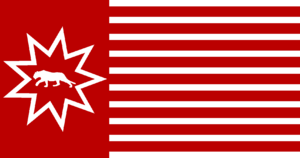Skarmic people
Eskarmitzin | |
|---|---|
 Flag of the Skarmic tribal hierarchy | |
| Total population | |
| 3.5–5 million | |
| Regions with significant populations | |
| Skarmia | 2,217,760 |
| Languages | |
| Skarmic, Beleroskovi | |
| Religion | |
| Christianity, Skarmic neopaganism | |
The Skarmic people (also referred to as Satoians; Skarmic: Eskarmitzin) are an indigenous ethnic group native to Roskovia, specifically to the highlands that form the border between Skarmia and Ossotia. Most Skarmic people still reside in their ethnic homeland, with the majority living in Skarmia, a country in which they comprise a plurality of the population. Various international groups estimate that there could be anywhere from 3.5 million to 5 million Skarmic people living worldwide.
The Skarmic language is the ancestral language of the Skarmic people, and the dominant religion among most Skarmic people is Christianity, though a significant subset of the population now follow a revived Skarmic neopaganism. The region in which they inhabit has been subject to a number of invasions, and is generally rugged and harsh, shaping the Skarmic national identity.
The nine-pointed star (or enneagram) is a prominant Skarmic symbol, as well as the snow lion and Itamochi (crossed spears and a shield), all three of which appear on the Federal Seal of Skarmia. Red is a colour primarily associated by the Skarmic people with life, vitality and humanity, and is considered the colour of the "Skarmic nation". The nine points on the enneagram represent the nine Skarmic tribes recognised within the Skarmic tribal hierarchy: the Kekatli, the Samatli, the Ronekche, the Pepini, the Énti, the Nilagi, the Pochi, the Piisa and the Silochi.
Historically a martial culture, Skarmic people served as mercenaries for Imperial Beleroskov, before being incorporated into Beleroskov's army formally as the Highlander Guard, a military designation that still exists today within the Skarmian Defence Services.
Ethnonyms
Skarmic, Eskarmitzin
The word "Skarmic" is a recent invention, being a back-formation from the Skarmic name for the nation of Skarmia, that being Eskarmik. Eskar, the Skarmic word for 'nine', and mik, the Skarmic word for 'nation', were merged to form a word meaning "nation of nine". Substituting the word for 'nation' with the word tzin, meaning 'people' gives the name Eskarmitzin, the current most-prominent Skarmic-language ethnonym. The Beleroskovi Skarmicheskii, or in some variants just Skarmik, was adopted as the largest universal ethnonym for the people, "Skarmic" from the Skarmic word Eskarmik, referring to the nation and not necessarily the people group.
Satoian
Prior to the upswing of nationalism in Skarmia, during the Imperial era, the Skarmic people called themselves Satöjir, often adopted as Satoii in Beleroskovi and as "Satoian" in English. Satöjir came from the Skarmic words satöm, meaning customs of a culture, and jir, meaning 'the same', thus meaning something akin to "those of the same customs".